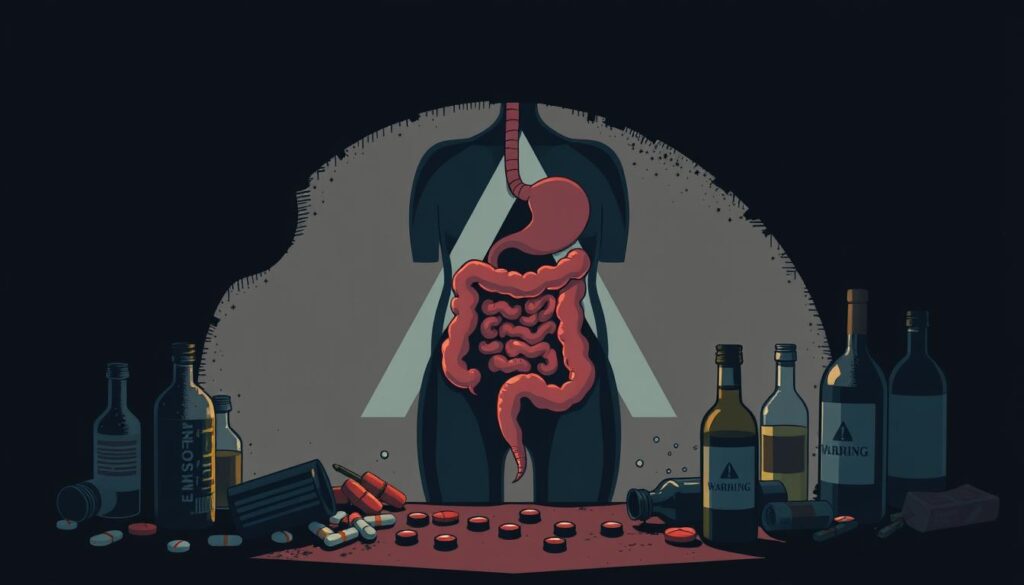Boofing involves ingesting drugs anally to achieve a faster, more intense high. It’s also called “booty bumping,” “hooping,” “plugging,” “butt chugging,” and “keistering.” The rectum’s thin surface and many blood vessels allow rapid drug absorption.
This method of drug use can lead to serious health problems. It poses significant risks and can have severe consequences for users.
Table of Contents
ToggleKey Takeaways
- Boofing is a dangerous practice that involves administering drugs rectally to achieve a faster and more intense high.
- Substances commonly boofed include illicit drugs like methamphetamine, cocaine, MDMA, and heroin, as well as misused prescription medications.
- Boofing bypasses the liver and digestive system, leading to rapid drug absorption and a stronger effect.
- Boofing poses significant health risks, including a high risk of overdose, tissue damage, infections, and long-term addiction.
- Seeking professional help through addiction treatment programs is crucial for those struggling with boofing and substance abuse.
Introduction to Boofing
Definition and Slang Terms
Boofing is inserting drugs into the rectum to get high. This method poses unique dangers. Slang terms like “booty bumping” and “hooping” reflect societal discomfort with this practice.
Users insert substances like meth, cocaine, and alcohol for a quick, intense high. Meth users feel effects within 3-5 minutes. Rectal administration offers faster onset than oral ingestion.
Boofing risks include HIV, hepatitis, and STIs due to anal tears. With alcohol, it bypasses stomach processing, causing rapid intoxication. This increases alcohol poisoning risk, as the body can’t expel excess through vomiting.
“Boofing is referred to as ‘rectal administration,’ with another term being ‘plugging.'”
The method involves injecting dissolved drugs or using suppositories for slower release. Common boofed drugs are heroin, cocaine, meth, and alcohol.
People boof drugs due to nose damage, blocked nasal passages, or for novelty. Some believe it increases effects or reduces risks.
The Process of Boofing Drugs
Boofing is a risky method of taking drugs through the anal cavity. It’s also called plugging or butt-chugging. This practice can involve various substances, including illegal and prescription drugs.
Common drugs used for boofing include methamphetamine, cocaine, MDMA, heroin, and synthetic cathinones. Prescription drugs like opioids and benzodiazepines are also used.
Substances Commonly Boofed
- Methamphetamine
- Cocaine
- MDMA
- Heroin
- Synthetic cathinones
- Opioids
- Benzodiazepines
Materials Used
The process involves dissolving the drug in liquid and using an applicator. The solution is then inserted into the rectum. This method allows for quick absorption into the bloodstream.
Step-by-Step Guide
- Dissolve the drug in a small amount of water or other liquid.
- Use an oral syringe or other applicator to draw up the solution.
- Carefully insert the applicator into the rectum and slowly release the contents.
- Wait for the effects of the drug to take hold, which can occur within minutes.
This practice is dangerous and can lead to serious health problems. It can cause damage to the rectum and intestines. There’s also a higher risk of STIs and drug overdose.
Why People Boof Drugs
People boof drugs to get a faster and stronger high. This method lets drugs enter the bloodstream quickly. It appeals to those seeking intense highs or with high drug tolerance.
Boofing means taking drugs through the anus for a rapid high. Common drugs for boofing include heroin, cocaine, and methamphetamine. When boofed, meth typically takes 3 to 5 minutes to work, giving a quicker onset of effects.
Some find boofing sexually arousing, while others find it uncomfortable. The appeal of boofing may come from skipping the digestive system. This leads to a faster, more intense high.
| Substance | Time to Take Effect (Boofed) |
|---|---|
| Methamphetamine | 3-5 minutes |
| Heroin | 2-10 minutes |
| Cocaine | 5-15 minutes |
The reasons for boofing include wanting a stronger high or faster effects. Some also feel sexual arousal. However, this practice is risky and can have serious health consequences.
Health Risks and Side Effects
Boofing is a risky drug practice that involves the rectum. It can cause immediate and long-term health problems. This method can damage sensitive rectal tissues and lead to infections.
Physical Health Risks
Boofing can harm the rectum and intestinal walls. It may cause overdose due to rapid drug absorption. Rectal irritation can result in painful, bloody stools.
Infections and STIs
Inserting objects can tear rectal tissues, allowing harmful bacteria to enter. This increases the risk of serious infections. Sharing equipment may spread STIs like HIV and hepatitis.
Anal Damage and Complications
Repeated boofing can lead to severe issues like incontinence. It may cause rectal prolapse or require a colostomy. Chronic irritation can impair normal bowel function.

Seek medical help if you’re struggling with boofing or substance abuse. Professional addiction treatment can address underlying causes. Proper care helps reduce the severe health risks of this dangerous practice.
Overdose Risks and Symptoms
Boofing, or rectal drug use, greatly increases overdose risk. It bypasses the body’s defenses, like liver metabolism. This can quickly lead to dangerous drug levels in the blood.
Boofing overdose symptoms include a limp body and nausea. Slowed breathing, blue extremities, and dilated pupils are also signs. Seizures, heart attacks, and strokes can occur in severe cases.
The dangers of boofing are severe, as the rapid absorption of drugs can overwhelm the body’s systems and result in life-threatening emergencies.
- A 2018 case series indicates that peer pressure plays a role in excessive alcohol consumption and drinking games involving alcohol enemas.
- According to a 2019 article, non-oral alcohol consumption is typically aimed at achieving rapid intoxication, with enemas allowing alcohol to enter the body faster by bypassing the gastrointestinal tract.
- Individuals may use non-oral alcohol ingestion to avoid the smell of alcohol on their breath, reduce calorie consumption, or lower the risk of vomiting and hangovers.
The boofing overdose risk is higher because people may not vomit after rectal drug use. However, their bodies can’t process substances well, increasing overdose danger.
Immediate medical help is vital if overdose signs appear. Don’t wait to call for help.
Knowing overdose symptoms and boofing dangers can prevent fatal outcomes. Seek professional help and use harm reduction strategies to manage risks.
Boofing and Substance Abuse Disorder
Boofing, or inserting drugs rectally, can lead to substance abuse disorders. This method causes intense, rapid drug effects, making it highly addictive. Quitting or reducing drug use becomes challenging for users.
Signs of Addiction
Some signs of addiction related to boofing include:
- An inability to quit or reduce drug use
- Spending excessive time and resources on obtaining and using the substance
- Neglecting personal and professional responsibilities in favor of getting high
Psychological and physical dependence on boofing makes recovery particularly difficult. Rapid substance absorption through the rectum quickly leads to tolerance and cravings. This fuels the addiction cycle further.
| Substance | Effects of Boofing | Overdose Risks |
|---|---|---|
| Stimulants (e.g., cocaine, methamphetamine) | Increased bioavailability, faster onset of effects | Heart attack, stroke, seizure |
| Opioids (e.g., heroin, prescription pills) | Rapid absorption, heightened intoxication | Respiratory depression |
| Alcohol | Quicker intoxication, bypassing liver metabolism | Alcohol poisoning, overdose |
Boofing’s increased risks and potency can drive users to seek more intense highs. This worsens the addiction over time. Professional help from addiction centers like Skywood Recovery is crucial for addressing boofing-related disorders.
What Is Boofing
Boofing involves inserting drugs into the rectum for a faster, more intense high. It’s also called “butt chugging” or “plugging”. The rectum’s thin surface and many blood vessels allow quick absorption into the bloodstream.
This method aims for faster intoxication from alcohol or drugs. Tragic cases include a man’s death from a “sherry enema”. A student was hospitalized after using alcohol enemas. Risks include rectal damage and higher overdose chances.
Boofing involves rectal insertion of illicit drugs or alcohol, aiming for a quicker and more intense high than other administration routes. Substances used include cocaine, meth, MDMA, heroin, opioids, and benzodiazepines. Ketamine, GHB, alcohol, and psychedelics can also be used.
Boofing can cause effects in 5 minutes, faster than snorting or swallowing. It increases drug absorption, up to 80% more than oral consumption for some substances.
However, boofing poses serious health risks. These include overdose, infections, and long-term damage to anal and rectal tissues.
“Boofing raises the risk of overdose due to difficulty controlling doses and effects timing, especially with opioids and stimulants.”
Boofing often indicates chronic substance abuse and addiction. It shows escalating risky behaviors to achieve a stronger high. Seeking expert help for boofing is crucial to prevent life-threatening consequences.
Psychological and Social Consequences
Boofing, or rectal drug use, can severely impact mental health and social life. It can worsen existing mental health issues and cause intense psychological distress. This risky behavior often leads to shame and isolation.
Studies show that women using substances like methamphetamine engage in heterosexual anal intercourse at varying rates. This behavior is linked to the psychological effects of boofing. It can result in feelings of shame and neglect of personal duties.
Boofing’s secretive nature often strains relationships and leads to social isolation. Research links heterosexual anal intercourse to increased STI and HIV risks. This is especially true among African American female teens.
| Psychological Impact | Social Consequences |
|---|---|
|
|
Boofing has serious psychological and social effects. Those involved in this risky practice should seek professional help. Support is crucial to address underlying issues and regain control.

“The secretive nature of boofing often results in social isolation, strained relationships, and the neglect of personal responsibilities, further compounding the negative impact on an individual’s overall well-being.”
Addiction and the Path to Recovery
Boofing, or rectal drug use, can lead to substance abuse disorders. Its intense effects are highly addictive, making recovery challenging. However, comprehensive treatment can help individuals achieve a drug-free life.
Therapy and Treatment Options
Overcoming boofing addiction requires a multifaceted approach. Evidence-based therapies like counseling and medication-assisted treatment are crucial. These methods address addiction’s root causes and provide strategies for managing cravings.
Behavioral therapies help develop healthy coping mechanisms. They tackle the psychological aspects of addiction. Cognitive-behavioral therapy and contingency management are effective examples.
Medication-Assisted Treatment can alleviate withdrawal symptoms and reduce cravings. It’s often used with counseling to support long-term recovery. Buprenorphine and methadone are common medications.
- Counseling: Behavioral therapies, including cognitive-behavioral therapy (CBT) and contingency management, help individuals develop healthy coping mechanisms and overcome the psychological aspects of addiction.
- Medication-Assisted Treatment (MAT): Medications like buprenorphine or methadone can be used in combination with counseling to alleviate withdrawal symptoms and reduce cravings, supporting long-term recovery.
- Rehabilitation Programs: Inpatient or outpatient rehabilitation programs offer a structured environment, comprehensive care, and the support of a dedicated team of professionals to guide individuals through the recovery process.
Addressing addiction’s complex nature helps develop tools for recovery. With proper support and treatment, overcoming boofing addiction is possible. Individuals can reclaim their lives and build a healthier future.
“Recovery from boofing addiction is a journey, not a destination. With the right support and treatment, individuals can break the cycle of addiction and build a healthier, more fulfilling life.” – Dr. Sarah Johnson, Addiction Therapist
Harm Reduction Strategies
Harm reduction strategies help lower risks linked to boofing. These include providing harm reduction kits with tools for safer use. Such kits can greatly reduce infections and injuries.
Education and Prevention
Education programs inform people about boofing dangers and safer drug use methods. These programs give people knowledge to make better choices. They also promote safer drug habits.
The National Harm Reduction Coalition offers extensive training yearly. They work to ensure syringe access in all states. Their efforts help local groups learn and use harm reduction practices.
Harm reduction programs team up with community leaders. They aim to change policies that put drug users at risk. Through action, they fight stigma and promote evidence-based approaches.
Focusing on harm reduction for boofing and education empowers people to make smart choices. Safer drug use strategies can lower risks linked to this dangerous practice.
Conclusion
Boofing, inserting drugs into the rectum, is a dangerous method of drug use. It may seem appealing for a faster high, but the risks are severe. These include overdose, infections, and long-term damage to the anal and rectal areas.
Understanding the serious effects of boofing is crucial. If you’re struggling with substance abuse, seek professional help. It’s important to promote harm reduction and raise awareness about this issue.
We need to work together to reduce this risky behavior. Our goal should be helping those affected find a path to recovery. A comprehensive approach is necessary to address this problem.
Boofing has far-reaching consequences. It’s vital that individuals, communities, and healthcare providers join forces. Together, we can prevent this harmful practice and provide resources for those battling substance abuse.
FAQ
What is boofing?
Boofing is a method of taking drugs through the rectum. It’s also called “booty bumping,” “hooping,” “plugging,” “butt chugging,” or “keistering.” People use this method for a faster, more intense high.
The rectum’s thin surface and many blood vessels allow drugs to enter the bloodstream quickly. This leads to rapid absorption of substances.
What substances are commonly boofed?
People boof various substances, including illegal and prescription drugs. Common illegal drugs are meth, cocaine, MDMA, heroin, and synthetic cathinones. Prescription drugs like opioids and benzodiazepines are also used.
Why do people boof drugs?
People boof drugs to get a faster and stronger high. This method lets drugs skip the digestive system. Instead, they go straight into the bloodstream.
What are the health risks of boofing?
Boofing can cause serious health problems, both now and later. It can damage rectal tissue and increase the risk of infections. There’s also a higher chance of getting sexually transmitted infections.
The quick absorption of drugs through boofing makes overdose more likely. This practice can lead to immediate and long-term health issues.
How can boofing lead to addiction?
Boofing can quickly lead to drug addiction. The intense and fast-acting effects are highly addictive. Signs of addiction include being unable to stop using drugs.
People might spend too much time and money getting and using drugs. They may also neglect their personal and work responsibilities to get high.
What are the psychological and social consequences of boofing?
Boofing can seriously affect a person’s mental health and social life. It can make existing mental health problems worse. The practice may lead to anxiety, depression, and acute psychological distress.
Boofing is often done in secret, which can cause social isolation. It can strain relationships and make people neglect their responsibilities.
How can harm reduction strategies help mitigate the risks of boofing?
Harm reduction strategies can help lower the risks of boofing. Providing harm reduction kits can reduce infections and injuries. These kits include tools for safer drug use.
Education programs are also important. They teach about the dangers of boofing. They also promote safer ways to use drugs. This can help prevent people from starting or continuing this risky practice.

